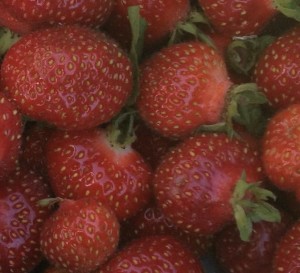
July
Picking & Handling:
Choose plump, firm, deep-colored strawberries, with bright green caps and no signs of mold or soft spots. Store strawberries in a flat box so that they are not stacked on top of each other to prevent the berries from squishing each other. They can be refrigerated 1 to 2 days. Wash & hull the strawberries just before using. Rinse the berries and do not soak them long in the water or they will become water laden. Strawberries are best eaten freshly picked. Locally picked strawberries will be juicier and taste much sweeter than store bought varieties.
Nutritional Information:
| Calories | Protein | Fat | Sat. Fat | % Cal. Fat | Sodium |
| 50 | 1.0 gms | 0.0 gms | 0.0 gms | 0% | 0.0 mg |
| Carbs | Fibre | Vit. A | Vit. C | Calcium | Iron |
| 13 gms | 3.0 gms | 0% RDA | 140% RDA | 2% RDA | 2% RDA |
(based on 1 cup of fresh strawberries)
Strawberries are low in calories and fats but a rich source of health promoting phyto-nutrients, minerals, and vitamins that are essential for optimum health. Strawberries have significantly high amounts of phenolic flavonoid phyto-chemicals called anthocyanins and ellagic acid. Scientific studies show that consumption of these berries may have potential health benefits against cancer, aging, inflammation and neurological diseases. Strawberries have an ORAC value (oxygen radical absorbance capacity, a measure of anti-oxidant strength) of about 3577µmol TE per 100 grams. Fresh strawberries are an excellent source of vitamin-C (100 g provide 58.8 mg or about 98% of RDI), which is also a powerful natural antioxidant. Consumption of fruits rich in vitamin C helps the body develop resistance against infectious agents, counter inflammation and scavenge harmful free radicals. Strawberries are rich in B-complex group of vitamins. They contain vitamin B-6, niacin, riboflavin, pantothenic acid and, folic acid. These vitamins help the body to metabolize carbohydrate, proteins and fats. Strawberries contain vitamin A, vitamin E and health promoting flavonoid poly phenolic antioxidants such as lutein, zea-xanthin, and beta-carotene in small amounts. These compounds help act as protective scavengers against oxygen-derived free radicals and reactive oxygen species (ROS) that play a role in aging and various disease processes. Strawberries also contain minerals like potassium, manganese, fluorine, copper, iron and iodine. Potassium is important because it helps controlling heart rate and blood pressure. Manganese is used by the body as a co-factor for the antioxidant enzyme, superoxide dismutase. Copper is required in the production of red blood cells. Iron is required for red blood cell formation. Fluoride is a component of bones and teeth and is important for prevention of dental cavities.
Facts:
The strawberry is a small plant of the Rosaceae (Rose) family. The strawberry grows close to the ground on a stem in clusters. It bears small white flowers which eventually develop into small greenish white fruits. The greenish white fruits turn to a rich red colour when they ripen. The strawberry plant has seeds on the outside skin rather than having an outer skin around the seed, as most berries do. They do not however, normally reproduce by seeds. When the fruit is developing, the plant sends out slender growths called runners. Runners grow on the ground and send out roots in the soil. The roots then produce new plants which grow and bear fruit. The runners can be removed and transplanted.
Our Strawberries:
We planted 9000 strawberry plants in the spring of 2016, another 5000 strawberry plants in 2017, and 5000 in the spring of 2018. Specifically we planted Kent strawberries. Kent is a vigorous mid-season variety which produces high yields of bright red fruit. These delicious red berries are as juicy as they come. We chose this variety because it is one of the sweetest and most reliable varieties available.